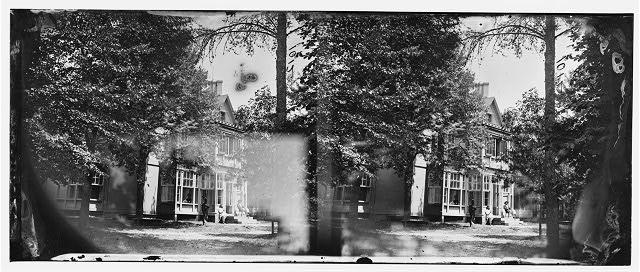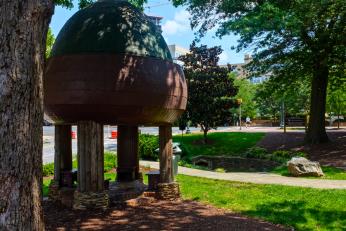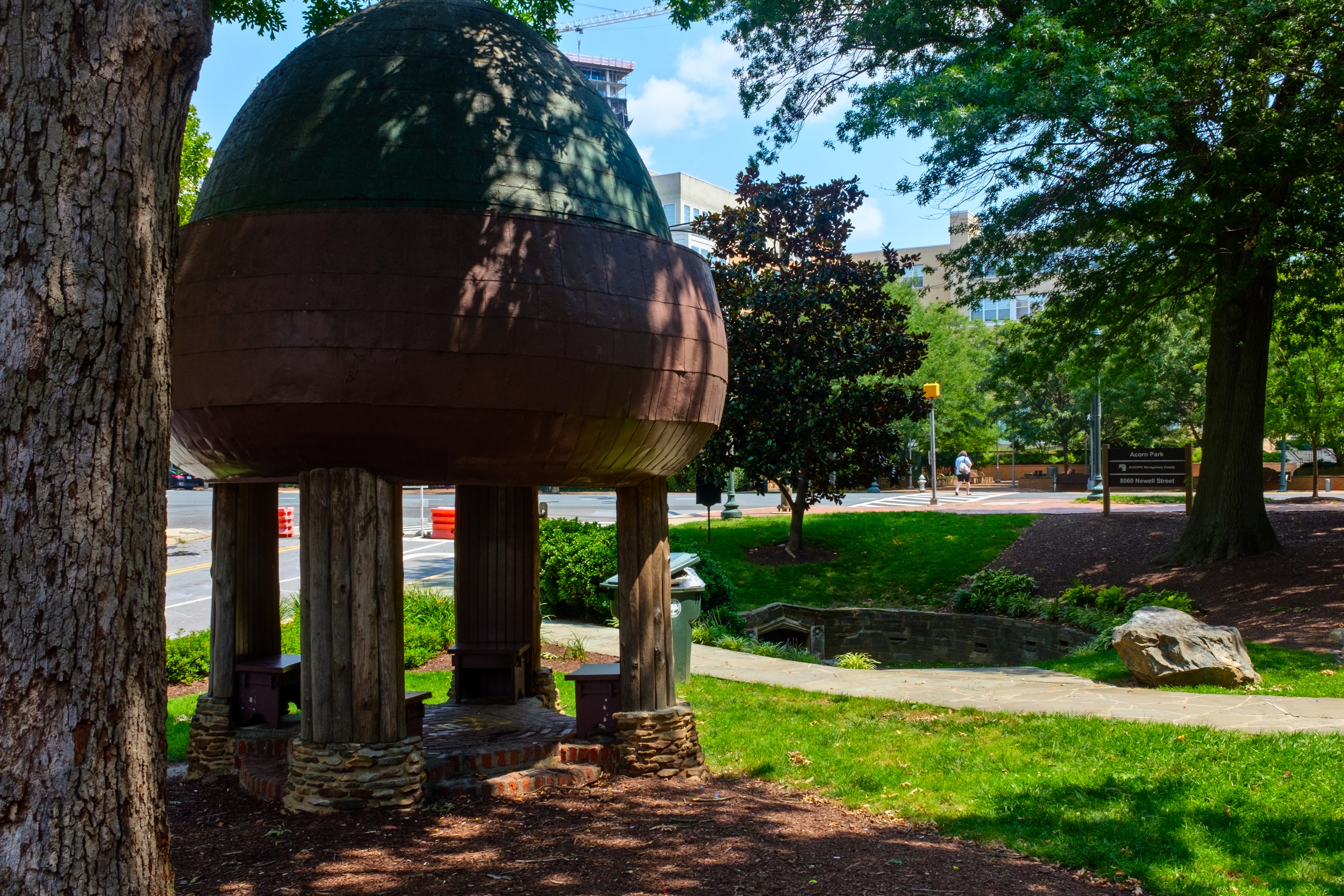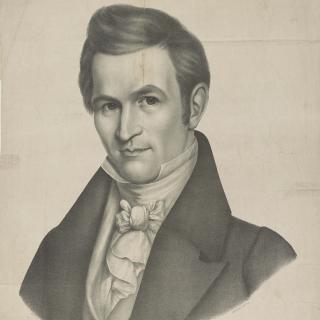What's in a Name? Silver Spring
In the 1970s, when the band Fleetwood Mac was on tour and traveling through the DMV, vocalist Stevie Nicks saw an exit sign that captured her imagination. “We were in Maryland somewhere, driving under a freeway sign that said ‘Silver Spring, Maryland,’” she recalled in a documentary. “And I loved the name.” To Nicks, it sounded like it described a magical and “pretty fabulous” place.[1] Inspired by the name, Nicks went on to write the song “Silver Springs,” a wistful breakup anthem about a romantic ideal.
Of course, those of us familiar with the Maryland suburb may laugh at Nicks’s romantic interpretation of the name. But listening to the song has made me wonder how Silver Spring landed one of the prettiest, most mystical-sounding names in the Washington, D.C. area. Was there really a magical silver spring that once flowed through the area? Is it as pretty and idyllic as it sounds?
Actually…yeah. That’s exactly where the name comes from: a “silver spring.”
In 1830, a newspaper man named Francis Preston Blair moved his family to Washington, D.C. Blair’s editorials in the local newspaper had caught the eye of President Andrew Jackson, who wanted him to head a new pro-administration newspaper in D.C. Soon, Blair wielded a lot of political power and wealth in the city. In 1837, the family could afford to move into a luxurious townhouse on Pennsylvania Avenue NW—a house that is still known as “Blair House” and is used by traveling foreign dignitaries.[2]
The Blairs soon found that they couldn’t stand being in the city during the summer—something we can easily imagine. The heat and humidity was uncomfortable, of course, but the Blairs also believed that it threatened their health. Medical experts believed that the bad air, or “miasma,” carried diseases that threatened the health of the city’s well-to-do. Anyone who could afford to purchase a second home in the countryside could pass the summer in much more bearable conditions. So, that’s what Francis Preston Blair did.[3] But where to build his summer estate, where he could enjoy the cooler conditions of the countryside while still being close to town?
In 1918, Blair’s grandson wrote a history of Silver Spring that (supposedly) explains just how his grandfather settled on the spot for his summer mansion. It’s an origin story romantic enough to satisfy Stevie Nicks. Apparently, Blair was riding his horse through Maryland, on his way back to D.C., when the horse was startled and threw him off. When Blair finally found his horse again, it was standing near “a beautiful spring full of white sand,” which “sparkled as it rose and fell like silver.”[4] In another version of the story, it’s actually Blair’s daughter, Elizabeth, who falls off the horse and discovers the spring.[5] Perhaps the horse, Selim, should actually be credited with the discovery? In any case, Blair was captivated by the little spring and resolved to purchase the land where it flowed, eventually building his summer mansion there. Aptly, they called the new house “the Silver Spring.”
Blair’s grandson remembers that the spring featured prominently in the house’s gardens, where the family could watch the water in a grotto they constructed over it:
“The column of shining silver…ever rising, ever falling, ever sparkling in the water and the sunlight, was presided over by a marble statue of a beautiful water nymph placed there by my grandfather, and it was endless joy for me, a little country boy, to sit and watch and dream upon this exquisite combination of white marble and living water.”[6]
The “shining silver” wasn’t just a fanciful description. Other histories of the spring confirm that it was a source of mica, a mineral that gives off a metallic sparkle in the light.[7] Against the white sand, it must have had a striking effect.
As the Blairs continued to rise in prominence, their home became a popular spot for D.C. politicians and society. As one of the early members of the Republican Party, Francis Preston Blair became a friend of President Abraham Lincoln, who visited the Silver Spring mansion often. When the local area was granted a post office in 1899, it took on the name of its most famous landmark—the mansion, not the actual spring. The Blair home stood until 1954, when it was demolished to make way for modern development.[8]
So, where is the famous silver spring now? Though it has apparently dried up, the location is still visible at Acorn Park in downtown Silver Spring. The acorn-shaped gazebo, the park’s namesake, definitely draws the most attention—but if you look into a little nook at the edge of the path, you can see the old grotto where the Blair family once watched the spring water flow. Certainly not as romantic as a Fleetwood Mac love song, but an interesting piece of local natural history.
Footnotes
- ^ Brittany Spanos, “Silver Springs: Inside Fleetwood Mac’s Great Lost Breakup Anthem,” Rolling Stone (2017), https://www.rollingstone.com/feature/silver-springs-inside-fleetwood-ma…
- ^ “History of the Home,” Blair House, http://www.blairhouse.org/history
- ^ Jerry A. McCoy and the Silver Spring Historical Society, Images of America: Historic Silver Spring (Arcadia Publishing, 2005), 7.
- ^ Gist Blair, “Annals of Silver Spring,” The Records of the Columbia Historical Society 21 (1918), 160.
- ^ McCoy, 7.
- ^ Ibid.
- ^ Hamill Kenny, The Placenames of Maryland: Their Origin and Meaning (Maryland Historical Society: 1984), 242.
- ^ “Acorn Urban Park,” Montgomery Parks, https://montgomeryparks.org/parks-and-trails/acorn-urban-park/








![Sketch of the mythical fuan by Pearson Scott Foresman. [Source: Wikipedia]](/sites/default/files/styles/crop_320x320/public/2023-10/Goatman_Wikipedia_Faun_2_%28PSF%29.png?h=64a074ff&itok=C9Qh-PE1)












